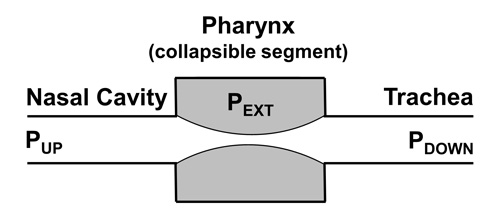Contact Us!
For more information on the Respiratory Biomechanics Laboratory, contact Dr. Guilherme Garcia.
Report a Problem
To report a problem with this website, contact BME Communications or report an accessibility issue.
Research Methodologies | Select Publications
To gain a better understanding of the biomechanics of upper airway collapse in patients with obstructive sleep apnea (OSA), the Airway Biomechanics Laboratory employs in vitro experiments in collapsible tubes (Starling Resistor) and 3D-printed upper airway replicas, fluid-structure interaction (FSI) simulations, and in vivo measurements performed during drug-induced sedated endoscopy (DISE). With the help of these tools, the Airway Lab seeks to improve our understanding of OSA pathophysiology and to develop virtual surgery planning tools to optimize surgical outcomes for patients with OSA.
Starling Resistor Experiments
 The Starling resistor is the paradigm biomechanical model of airway collapse in OSA. It consists of a collapsible tube (representing the pharynx) located between two rigid tubes (representing the nasal cavity and trachea).
The Starling resistor is the paradigm biomechanical model of airway collapse in OSA. It consists of a collapsible tube (representing the pharynx) located between two rigid tubes (representing the nasal cavity and trachea).
Starling Resistor Experiment
FSI Simulations of the Starling Resistor
In the Airway Biomechanics Laboratory, FSI simulations of the Starling resistor are performed with ANSYS software.
FSI Simulation of the Starling Resistor (view 1)
FSI Simulation of Starling Resistor (view 2)
Drug Induced Sedated Endoscopy
In collaboration with Dr. Tucker Woodson (MCW Department of Otolaryngology), our lab has performed in vivo measurements of airway collapsibility in patients with obstructive sleep apnea during drug-induced sedated endoscopy (DISE).
Drug Induced Sedated Endoscopy
3D-Printed Replica of the Human Upper Airway
The Airway Lab uses 3D-printing technology to create replicas of the human upper airway with a collapsible (silicone) pharynx.

The video below shows the upper airway replica being used in an experiment. Notice that when the left nostril is obstructed with a finger (increasing the upstream resistance and decreasing the pressure at the pharynx), the flexible pharynx collapses.
Airway Replica Experiment
Kumar D., Woodson B.T., Garcia G.J.M. (2025) Phenotypes of velopharyngeal tube law in obstructive sleep apnea. Otolaryngology—Head and Neck Surgery 172, 336-345.
Garcia G.J.M. and Woodson B.T. (2024) Do patients with multilevel collapse need multilevel surgery? JAMA Otolaryngology—Head & Neck Surgery 150, 877-878.
Hartfield P.J., Janczy J., Sharma A., Newsome H.A., Sparapani R.A., Rhee J.S., Woodson B.T., Garcia G.J.M. (2023) Anatomical determinants of upper airway collapsibility in obstructive sleep apnea: A systematic review and meta-analysis. Sleep Medicine Reviews 68, 101741.
Garcia G.J.M., Wolf J.J., Campbell D.A., Bailey R.S., Sparapani R.A., Welzig C.M., Woodson B.T. (2023) Mandibular advancement reduces pharyngeal collapsibility by enlarging the airway rather than affecting velopharyngeal compliance. Physiological Reports 11 (3), e15558, 1–18.
Zarandi M.A.F., Garman K., Rhee J.S., Woodson B.T., Garcia G.J.M. (2021) Effect of tube length on the buckling pressure of collapsible tubes. Computers in Biology and Medicine 136, 104693, 1–8.
Garcia G.J.M. and Woodson B.T. (2020) The collapsing anatomical structure is not always the primary site of flow limitation in obstructive sleep apnea. Journal of Clinical Sleep Medicine 16, 345–346.
Le T.B., Moghaddam M.G., Woodson B.T., Garcia G.J.M. (2019) Airflow limitation in a collapsible model of the human pharynx: Physical mechanisms studied with fluid-structure interaction simulations and experiments. Physiological Reports 7 (10), e14099, 1-16.
The team at the Airway Biomechanics Laboratory is always looking for hard-working researchers with an interest in respiratory physiology and computational modeling. For more information on becoming a member of our research team, contact Dr. Garcia.